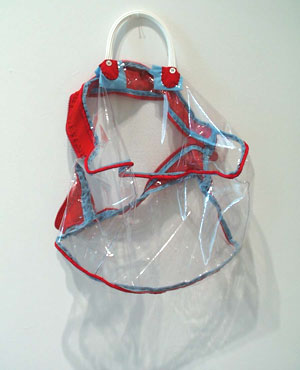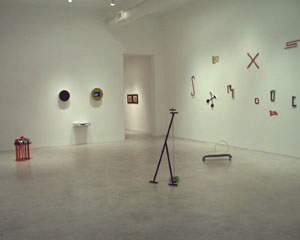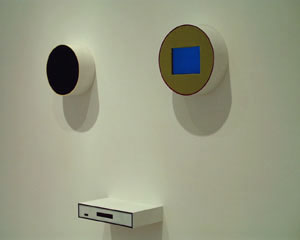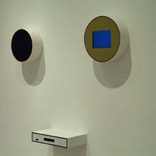Brad Tucker’s new work in Long Distance Lovers at Inman Gallery might be first cousin to clothes by Winona Ryder-endorsed fashion designer Marc Jacobs.
Tucker’s forms – freestanding and wall-mounted – share with Jacobs’ designs a tendency towards rounded geometry, a post-post-seventies palette of sherbet colors and earth tones, and a confidently deployed simplicity which suggests that there’s more to it than you might first guess.
In Jacobs’ case, these traits have secured his position as the designer we can all get behind in a recession (he thrived in the last one by commodifying “grunge”). This time around, I’d argue that he’s tapped into a desire to wear and own things that feel simultaneously considered/designed (like an iMac) and homemade/nostalgic (like something from Bert and Ernie’s closet). The product is perfect for its day because it balances the audacity and pleasure of design with the unselfconsciousness and humility appropriate to lean times, resulting in something super-livable.
Which is not to imply that Tucker’s work is about fashion; it isn’t. Nor is his art particularly fashionable (although DeKooning’s Handbag looks more like a Marc Jacobs handbag than the real thing). But Tucker’s work is livable and familiar, and he uses some of the same tropes that fashion is using to engage us with his personal themes.

Brad Tucker, Travelin’ Piece (de Kooning’s Handbag), 2003... plastic, vinyl, fabric 21" x 16" x 5 1/2 "
In Long Distance Lovers, Tucker’s dominant theme is the reduction of music and language to their most basic components: letters and notes. His approach is playful rather than methodical, and it takes advantage of the messy similarities between the two systems. Scattered across the large wall of the gallery, letters solely in the written/spoken language (a Westinghouse “W”) commingle with letters that form the basis of musical language as well (a snake-patterned “C” designated C Chord). Assembled or formed from wood and painted, some of these letters are more letter-like than others, and they share the wall with abstractions that are suspiciously similar, but titled Winding Path rather than “S” and Soccer Player rather than “F.” Like staring at a word so long that it ceases to have meaning, the wall as a whole dismantles the relationship between the design of each letter and its usefulness.
The utility that Tucker removes from letters in his paintings is restored to them in a video sculpture titled Streaming. In two short exercises, Tucker randomly disperses letters – small ones on a turntable, large ones into a stream – and then plays music along to the resulting score that the physical movement of the letters produces. By themselves, the songs that emerge from these exercises have only an intellectual, late-night-college-radio appeal. But coupled with the video of the act that generated them, the songs become elegant explanations of how music works. In a third exercise, Love Me Tender plays on accordion and guitar. Two slide projectors accompany the music: the first with photographs of Tucker’s hands fretting chords on the guitar, the second with a faster-playing series of musical notes that represents the melody. This, the most musical exercise, rounds out the trio by replacing the camera as musical instrument with the camera as recording device. It connects the piece to Tucker’s earlier recorded pieces and demonstrates that all variables (score, instruments, time, recording device…) have been considered.
Several of the best pieces in the show have little or nothing to do with Tucker’s alphabet game. And yet every piece comes from the same family tree and adheres to his handicraft-meets-high-design aesthetic. When he goes off-topic to take on Ellsworth Kelly or Frank Stella, he gives them the same easy monkey wrench disassembly that he’s applied to music and words. Even would-be arbitrary connections between his previous cast plastic flip-flops and his current cast plastic floppy disks run on clang association between the names of the two disposable pop products.
It’s not irrelevant to point out that Brad Tucker is, by day, a schoolteacher and that his job requires connecting aspirations to fundamentals; selling the unappealing fact that seemingly exciting careers are built on a foundation of long division, agreeing pronouns, and historical precedent. In Long Distance Lovers, Tucker has taken the unglamorous component elements of language, music, and modernism and made them fascinating, not as steps towards something greater, but as containers for humor, nostalgia, and intelligence by themselves.
All images appear courtesy the artist and Inman Gallery.
David Harrison is a writer and photographer living in Houston.





